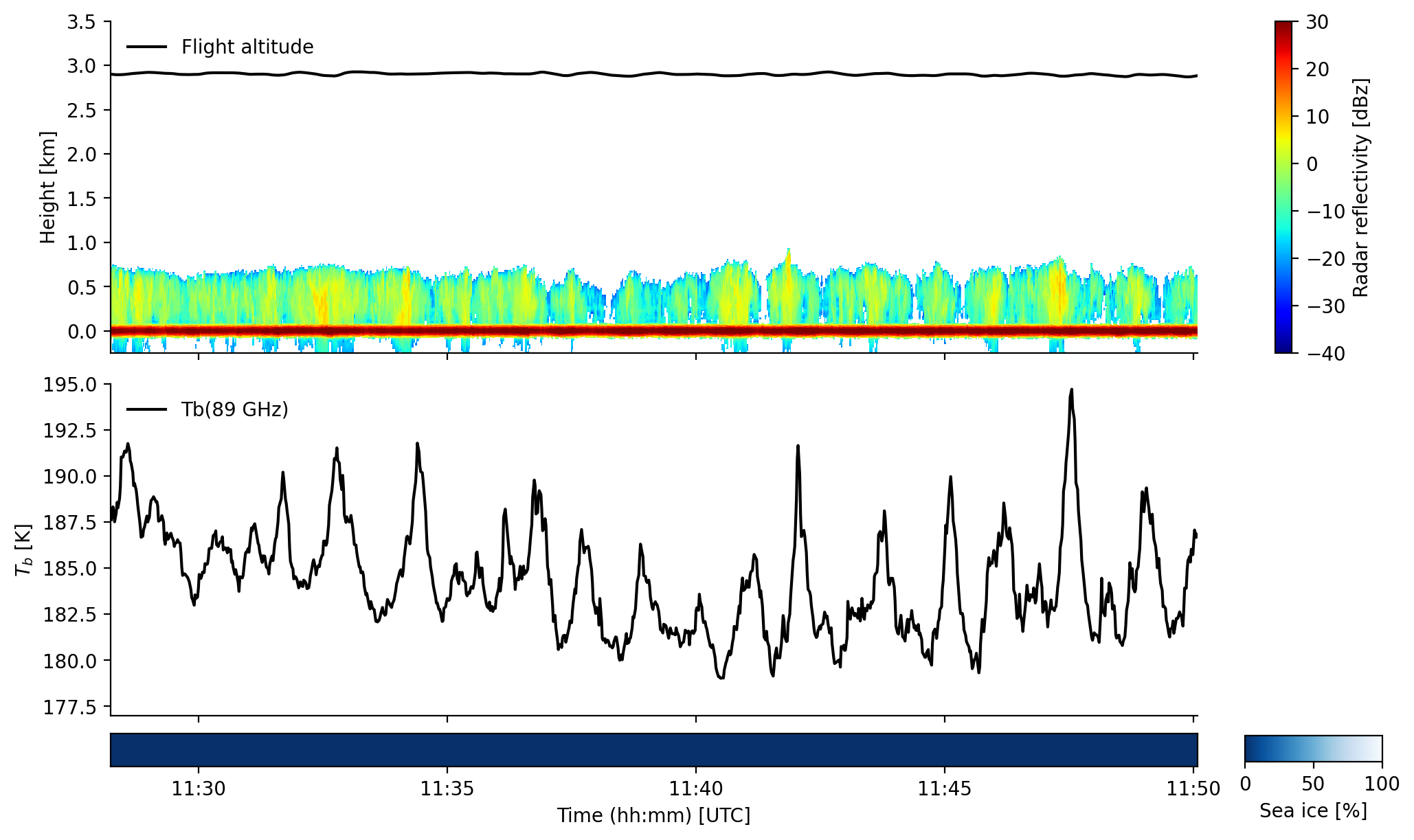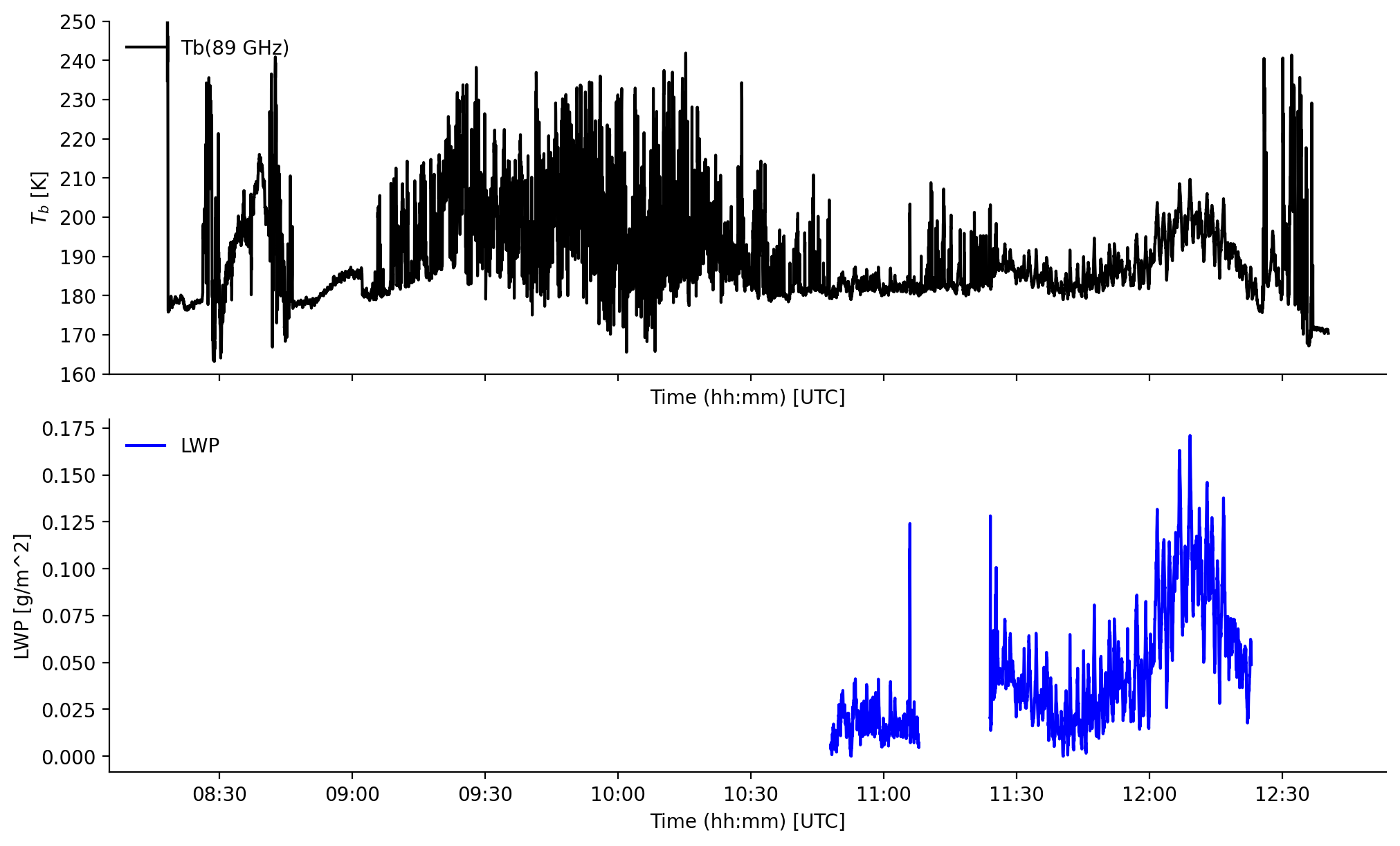MiRAC-A#
The following example demonstrates the use of MiRAC-A data collected during ACLOUD, AFLUX, and MOSAiC-ACA. The Microwave Radar/Radiometer for Arctic Clouds (MiRAC) consists of an active component, a 94 GHz Frequency Modulated Continuous Wave (FMCW) cloud radar, and a passive 89 GHz microwave radiometer. MiRAC-A is mounted on Polar 5 with a fixed viewing angle of 25° against flight direction.
More information on the instrument can be found in Mech et al. (2019).
In addition, the liquid water path product over open ocean derived from the passive channel during the ACLOUD campaign Kliesch et al. (2021) is included.
If you have questions or if you would like to use the data for a publication, please don’t hesitate to get in contact with the dataset authors as stated in the dataset attributes contact or author.
Data access#
Some of the data, like the preliminary data of the HALO-(AC)3 campaign, is stored on the (AC)3 nextcloud server. This requires username and password as credentials (registration) that need to be loaded from environment variables
import os
from dotenv import load_dotenv
load_dotenv()
# local caching
kwds = {'simplecache': dict(
cache_storage=os.environ['INTAKE_CACHE'],
same_names=True
)}
To analyse the data they first have to be loaded by importing the (AC)3 airborne meta data catalogue. To do so the ac3airborne package has to be installed. More information on how to do that and about the catalog can be found here.
import ac3airborne
cat = ac3airborne.get_intake_catalog()
datasets = []
for campaign in ['ACLOUD', 'AFLUX', 'MOSAiC-ACA','HALO-AC3','COMPEX-EC']:
datasets.extend(list(cat[campaign]['P5']['MiRAC-A']))
datasets.extend(list(cat['HAMAG']['P6']['MiRAC-A']))
datasets
['ACLOUD_P5_RF04',
'ACLOUD_P5_RF05',
'ACLOUD_P5_RF06',
'ACLOUD_P5_RF07',
'ACLOUD_P5_RF08',
'ACLOUD_P5_RF10',
'ACLOUD_P5_RF11',
'ACLOUD_P5_RF14',
'ACLOUD_P5_RF15',
'ACLOUD_P5_RF16',
'ACLOUD_P5_RF17',
'ACLOUD_P5_RF18',
'ACLOUD_P5_RF19',
'ACLOUD_P5_RF20',
'ACLOUD_P5_RF21',
'ACLOUD_P5_RF22',
'ACLOUD_P5_RF23',
'ACLOUD_P5_RF25',
'AFLUX_P5_RF03',
'AFLUX_P5_RF04',
'AFLUX_P5_RF05',
'AFLUX_P5_RF06',
'AFLUX_P5_RF07',
'AFLUX_P5_RF08',
'AFLUX_P5_RF09',
'AFLUX_P5_RF10',
'AFLUX_P5_RF11',
'AFLUX_P5_RF12',
'AFLUX_P5_RF13',
'AFLUX_P5_RF14',
'AFLUX_P5_RF15',
'MOSAiC-ACA_P5_RF05',
'MOSAiC-ACA_P5_RF06',
'MOSAiC-ACA_P5_RF07',
'MOSAiC-ACA_P5_RF08',
'MOSAiC-ACA_P5_RF09',
'MOSAiC-ACA_P5_RF10',
'MOSAiC-ACA_P5_RF11',
'HALO-AC3_P5_RF01',
'HALO-AC3_P5_RF03',
'HALO-AC3_P5_RF04',
'HALO-AC3_P5_RF05',
'HALO-AC3_P5_RF07',
'HALO-AC3_P5_RF08',
'HALO-AC3_P5_RF09',
'HALO-AC3_P5_RF10',
'HALO-AC3_P5_RF11',
'HALO-AC3_P5_RF12',
'HALO-AC3_P5_RF13',
'COMPEX-EC_P5_RF00',
'COMPEX-EC_P5_RF01',
'COMPEX-EC_P5_RF02',
'COMPEX-EC_P5_RF03',
'COMPEX-EC_P5_RF04',
'COMPEX-EC_P5_RF05',
'COMPEX-EC_P5_RF06',
'COMPEX-EC_P5_RF07',
'HAMAG_P6_RF01',
'HAMAG_P6_RF02',
'HAMAG_P6_RF03',
'HAMAG_P6_RF04',
'HAMAG_P6_RF05',
'HAMAG_P6_RF06']
From here on, we work on a specific flight from the ACLOUD campaign ACLOUD_P5_RF05.
flight = 'ACLOUD_P5_RF05'
campaign, platform, rf = flight.split('_')
Note
Have a look at the attributes of the xarray dataset ds_mirac_a for all relevant information on the dataset, such as author, contact, or citation information.
ds_mirac_a = cat[campaign][platform]['MiRAC-A'][flight](storage_options=kwds).to_dask()
ds_mirac_a
/net/sever/mech/miniconda3/envs/howtoac3/lib/python3.11/site-packages/intake_xarray/base.py:21: FutureWarning: The return type of `Dataset.dims` will be changed to return a set of dimension names in future, in order to be more consistent with `DataArray.dims`. To access a mapping from dimension names to lengths, please use `Dataset.sizes`.
'dims': dict(self._ds.dims),
<xarray.Dataset> Size: 149MB
Dimensions: (time: 11765, height: 1400)
Coordinates:
* time (time) datetime64[ns] 94kB 2017-05-25T08:18:18 ... 2017-05...
* height (height) float32 6kB -1e+03 -995.0 ... 5.99e+03 5.995e+03
Data variables:
Ze_unfiltered (time, height) float32 66MB ...
Ze (time, height) float32 66MB ...
tb (time) float32 47kB ...
Ze_flag (time, height) uint8 16MB ...
lon (time) float32 47kB ...
lat (time) float32 47kB ...
alt (time) float32 47kB ...
Attributes: (12/15)
title: MiRAC-A observations onboard Polar 5 during ACLOUD
institution: Institute for Geophysics and Meteorology (IGM), University ...
source: airborne observation
history: measured onboard Polar 5 during ACLOUD campaign; processed,...
references: https://doi.org/10.5194/amt-12-5019-2019
comment: the radar system and the 89 GHz channel were inclined by 25...
... ...
platform: Polar 5
flight_id: RF05
instrument: MiRAC-A: Microwave Radar/radiometer for Arctic Clouds (active)
author: Nils Risse
contact: mario.mech@uni-koeln.de, n.risse@uni-koeln.de
created: 2022-07-19The dataset includes the radar reflectivity (Ze, Ze_unfiltered), the radar reflectivity filter mask (Ze_flag), the 89 GHz brightness temperature (TB_89) as well as information on the aircraft’s flight altitude (altitude). The radar reflectivity is defined on a regular time-height grid with corresponding target positions (lat, lon). The full dataset is available on PANGAEA.
Load Polar 5 flight phase information#
Polar 5 flights are divided into segments to easily access start and end times of flight patterns. For more information have a look at the respective github repository.
At first we want to load the flight segments of (AC)³airborne
meta = ac3airborne.get_flight_segments()
The following command lists all flight segments into the dictionary segments
segments = {s.get("segment_id"): {**s, "flight_id": flight["flight_id"]}
for campaign in meta.values()
for platform in campaign.values()
for flight in platform.values()
for s in flight["segments"]
}
In this example we want to look at a high-level segment during ACLOUD RF05
seg = segments[flight + "_hl09"]
Using the start and end times of the segment ACLOUD_P5_RF05_hl09 stored in seg, we slice the MiRAC data to this flight section.
ds_mirac_a_sel = ds_mirac_a.sel(time=slice(seg["start"], seg["end"]))
ds_mirac_a_sel
<xarray.Dataset> Size: 12MB
Dimensions: (time: 981, height: 1400)
Coordinates:
* time (time) datetime64[ns] 8kB 2017-05-25T11:28:15 ... 2017-05-...
* height (height) float32 6kB -1e+03 -995.0 ... 5.99e+03 5.995e+03
Data variables:
Ze_unfiltered (time, height) float32 5MB ...
Ze (time, height) float32 5MB ...
tb (time) float32 4kB ...
Ze_flag (time, height) uint8 1MB ...
lon (time) float32 4kB ...
lat (time) float32 4kB ...
alt (time) float32 4kB ...
Attributes: (12/15)
title: MiRAC-A observations onboard Polar 5 during ACLOUD
institution: Institute for Geophysics and Meteorology (IGM), University ...
source: airborne observation
history: measured onboard Polar 5 during ACLOUD campaign; processed,...
references: https://doi.org/10.5194/amt-12-5019-2019
comment: the radar system and the 89 GHz channel were inclined by 25...
... ...
platform: Polar 5
flight_id: RF05
instrument: MiRAC-A: Microwave Radar/radiometer for Arctic Clouds (active)
author: Nils Risse
contact: mario.mech@uni-koeln.de, n.risse@uni-koeln.de
created: 2022-07-19In polar regions, the surface type is helpful for the interpretation of airborne passive microwave observations, especially near the marginal sea ice zone, as generally a higher emissivity is expected over sea ice compared to open ocean. Therefore, we also load AMSR2 sea ice concentration data along the Polar 5 flight track, which is operationally derived by the University of Bremen.
ds_sea_ice = cat[campaign][platform]['AMSR2_SIC'][flight](storage_options=kwds).to_dask().sel(
time=slice(seg["start"], seg["end"]))
/net/sever/mech/miniconda3/envs/howtoac3/lib/python3.11/site-packages/intake_xarray/base.py:21: FutureWarning: The return type of `Dataset.dims` will be changed to return a set of dimension names in future, in order to be more consistent with `DataArray.dims`. To access a mapping from dimension names to lengths, please use `Dataset.sizes`.
'dims': dict(self._ds.dims),
Plots#
The flight section during ACLOUD RF05 is flown at about 3 km altitude in west-east direction during a cold-air outbreak event perpendicular to the wind field. Clearly one can identify the roll-cloud structure in the radar reflectivity and the 89 GHz brightness temperature.
%matplotlib inline
import matplotlib.pyplot as plt
import matplotlib.dates as mdates
import numpy as np
plt.style.use("../../mplstyle/book")
fig, (ax1, ax2, ax3) = plt.subplots(3, 1, sharex=True, gridspec_kw=dict(height_ratios=(1, 1, 0.1)))
# 1st: plot flight altitude and radar reflectivity
ax1.plot(ds_mirac_a_sel.time, ds_mirac_a_sel.alt*1e-3, label='Flight altitude', color='k')
im = ax1.pcolormesh(ds_mirac_a_sel.time, ds_mirac_a_sel.height*1e-3, 10*np.log10(ds_mirac_a_sel.Ze).T, vmin=-40, vmax=30, cmap='jet', shading='nearest')
fig.colorbar(im, ax=ax1, label='Radar reflectivity [dBz]')
ax1.set_ylim(-0.25, 3.5)
ax1.set_ylabel('Height [km]')
ax1.legend(frameon=False, loc='upper left')
# 2nd: plot 89 GHz TB
ax2.plot(ds_mirac_a_sel.time, ds_mirac_a_sel.tb, label='Tb(89 GHz)', color='k')
ax2.set_ylim(177, 195)
ax2.set_ylabel('$T_b$ [K]')
#ax2.set_xlabel('Time (hh:mm) [UTC]')
ax2.legend(frameon=False, loc='upper left')
#ax2.xaxis.set_major_formatter(mdates.DateFormatter('%H:%M'))
# plot AMSR2 sea ice concentration
im = ax3.pcolormesh(ds_sea_ice.time,
np.array([0, 1]),
np.array([ds_sea_ice.sic,ds_sea_ice.sic]), cmap='Blues_r', vmin=0, vmax=100,
shading='auto')
cax = fig.add_axes([0.9, 0.085, 0.1, ax3.get_position().height])
fig.colorbar(im, cax=cax, orientation='horizontal', label='Sea ice [%]')
ax3.tick_params(axis='y', labelleft=False, left=False)
#ax3.spines[:].set_visible(True)
ax3.spines['top'].set_visible(True)
ax3.spines['right'].set_visible(True)
ax3.xaxis.set_major_formatter(mdates.DateFormatter('%H:%M'))
ax3.set_xlabel('Time (hh:mm) [UTC]')
plt.show()

LWP#
list(cat['ACLOUD']['P5']['MiRAC-A_LWP'])
['ACLOUD_P5_RF05',
'ACLOUD_P5_RF06',
'ACLOUD_P5_RF07',
'ACLOUD_P5_RF11',
'ACLOUD_P5_RF14',
'ACLOUD_P5_RF15',
'ACLOUD_P5_RF16',
'ACLOUD_P5_RF18',
'ACLOUD_P5_RF19',
'ACLOUD_P5_RF20',
'ACLOUD_P5_RF21',
'ACLOUD_P5_RF22']
ds_lwp = cat['ACLOUD']['P5']['MiRAC-A_LWP']['ACLOUD_P5_RF05'].to_dask()
/net/sever/mech/miniconda3/envs/howtoac3/lib/python3.11/site-packages/intake_xarray/base.py:21: FutureWarning: The return type of `Dataset.dims` will be changed to return a set of dimension names in future, in order to be more consistent with `DataArray.dims`. To access a mapping from dimension names to lengths, please use `Dataset.sizes`.
'dims': dict(self._ds.dims),
ds_lwp
<xarray.Dataset> Size: 424kB
Dimensions: (time: 11765)
Coordinates:
* time (time) datetime64[ns] 94kB 2017-05-25T08:18:18 ... 2017-05-2...
lat (time) float64 94kB ...
lon (time) float64 94kB ...
Data variables:
trajectory |S1 1B ...
alt (time) float32 47kB ...
status_flag (time) int32 47kB ...
lwp (time) float32 47kB ...
Attributes: (12/14)
institution: Institute for Geophysics and Meteorology, University of Col...
contact: l.kliesch@uni-koeln.de, mario.mech@uni-koeln.de
source: Kliesch and Mech (2019, doi: https://doi.org/10.1594/PANGAE...
Conventions: CF-1.7
title: LWP retrieval of MiRAC on Polar 5
variable: liquid water path (LWP)
... ...
campaign: ACLOUD: Arctic CLoud Observations Using airborne measuremen...
keywords: LWP, MiRAC, ACLOUD, Polar 5
featureType: trajectory
history: created: 2021-05-27
author: Leif-Leonard Kliesch
summary: LWP is retrieved nadir over sea-ice-free ocean from the 89 ...fig, (ax1, ax2) = plt.subplots(2, 1, sharex=True)
# 1st: plot 89 GHz TB
ax1.plot(ds_mirac_a.time, ds_mirac_a.tb, label='Tb(89 GHz)', color='k')
ax1.set_ylim(160, 250)
ax1.set_ylabel('$T_b$ [K]')
ax1.set_xlabel('Time (hh:mm) [UTC]')
ax1.legend(frameon=False, loc='upper left')
# 2nd: plot 89 GHz TB
ax2.plot(ds_lwp.time, ds_lwp.lwp, label='LWP', color='b')
#ax2.set_ylim(177, 195)
ax2.set_ylabel('LWP [g/m^2]')
ax2.set_xlabel('Time (hh:mm) [UTC]')
ax2.legend(frameon=False, loc='upper left')
ax2.xaxis.set_major_formatter(mdates.DateFormatter('%H:%M'))
plt.show()


